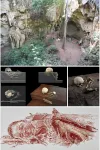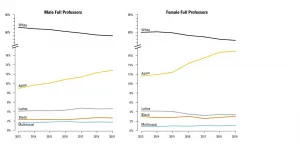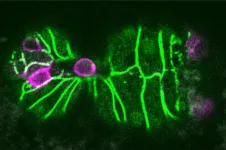(Press-News.org) Researchers at CRANN (The Centre for Research on Adaptive Nanostructures and Nanodevices), and the School of Physics at Trinity College Dublin, today announced that a magnetic material developed at the Centre demonstrates the fastest magnetic switching ever recorded.
The team used femtosecond laser systems in the Photonics Research Laboratory at CRANN to switch and then re-switch the magnetic orientation of their material in trillionths of a second, six times faster than the previous record, and a hundred times faster than the clock speed of a personal computer.
This discovery demonstrates the potential of the material for a new generation of energy efficient ultra-fast computers and data storage systems.
The researchers achieved their unprecedented switching speeds in an alloy called MRG, first synthesised by the group in 2014 from manganese, ruthenium and gallium. In the experiment, the team hit thin films of MRG with bursts of red laser light, delivering megawatts of power in less than a billionth of a second.
The heat transfer switches the magnetic orientation of MRG. It takes an unimaginably fast tenth of a picosecond to achieve this first change (1 ps = one trillionth of a second). But, more importantly, the team discovered they could switch the orientation back again 10 trillionths of a second later. This is the fastest re-switching of a magnet's orientation ever observed.
Their results are published this week in the leading physics journal, Physical Review Letters.
The discovery could open new avenues for innovative computing and information technology, given the importance of magnetic materials in this industry. Hidden in many of our electronic devices, as well as in the large-scale data centres at the heart of the internet, magnetic materials read and store the data. The current information explosion generates more data and consumes more energy than ever before. Finding new energy efficient ways to manipulate data, and materials to match, is a world-wide research preoccupation.
The key to the Trinity teams' success was their ability to achieve the ultrafast switching without any magnetic field. Traditional switching of a magnet uses another magnet, which comes at cost in terms of both energy and time. With MRG the switching was achieved with a heat pulse, making use of the material's unique interaction with light.
Trinity researchers Jean Besbas and Karsten Rode discuss one avenue of the research:
"Magnetic materials inherently have memory that can be used for logic. So far, switching from one magnetic state 'logical 0', to another 'logical 1', has been too energy hungry and too slow. Our research addresses speed by showing that we can switch MRG from one state to another in 0.1 picoseconds and crucially that a second switch can follow only 10 picoseconds later, corresponding to an operational frequency of ~ 100 gigahertz -- faster than anything observed before.
"The discovery highlights the special ability of our MRG to effectively couple light and spin so, that we can control magnetism with light and light with magnetism on hitherto unachievable timescales."
Commenting on his team's work, Professor Michael Coey, Trinity's School of Physics and CRANN, said:
"In 2014 when my team and I first announced that we had created a completely new alloy of manganese, ruthenium and gallium, known as MRG, we never suspected the material had this remarkable magneto-optical potential.
"This demonstration will lead to new device concepts based on light and magnetism that could benefit from greatly increased speed and energy efficiency, perhaps ultimately realising a single universal device with combined memory and logic functionality. It is a huge challenge, but we have shown a material that may make it possible. We hope to secure funding and industry collaboration to pursue our work."
INFORMATION:
The research that made the discovery possible was supported by Science Foundation Ireland, the Irish Research Council, and the European Commission.
Despite being home to the earliest signs of modern human behaviour, early evidence of burials in Africa are scarce and often ambiguous. Therefore, little is known about the origin and development of mortuary practices in the continent of our species' birth. A child buried at the mouth of the Panga ya Saidi cave site 78,000 years ago is changing that, revealing how Middle Stone Age populations interacted with the dead.
Panga ya Saidi has been an important site for human origins research since excavations began in 2010 as part of a long-term partnership between archaeologists from the Max Planck Institute for the Science of Human ...
AMHERST, Mass. - The world is currently on track to exceed three degrees Celsius of global warming, and new research led by the University of Massachusetts Amherst's Rob DeConto, co-director of the School of Earth & Sustainability, shows that such a scenario would drastically accelerate the pace of sea-level rise by 2100. If the rate of global warming continues on its current trajectory, we will reach a tipping point by 2060, past which these consequences would be "irreversible on multi-century timescales."
The new paper, published today in Nature, models the impact of several different warming scenarios on the Antarctic Ice Sheet, including the Paris Agreement target of two degrees Celsius of warming, an aspirational 1.5 degree scenario, ...
In 1 to 2 percent of cancer cases, the primary site of tumor origin cannot be determined. Because many modern cancer therapeutics target primary tumors, the prognosis for a cancer of unknown primary (CUP) is poor, with a median overall survival of 2.7-to-16 months. In order to receive a more specific diagnosis, patients often must undergo extensive diagnostic workups that can include additional laboratory tests, biopsies and endoscopy procedures, which delay treatment. To improve diagnosis for patients with complex metastatic cancers, especially those in low-resource settings, researchers from the Mahmood Lab at the Brigham and Women's Hospital developed an artificial intelligence (AI) system that uses routinely acquired histology slides to accurately find the origins of metastatic ...
The Antarctic ice sheet is much less likely to become unstable and cause dramatic sea-level rise in upcoming centuries if the world follows policies that keep global warming below a key END ...
Mitochondria either split in half to multiply within the cell, or cut off their ends to get rid of damaged material. That's the take-away message from EPFL biophysicists in their latest research investigating mitochondrial fission. It's a major departure from the classical textbook explanation of the life cycle of this well-known organelle, the powerhouse of the cell. The results are published today in Nature.
"Until this study, it was poorly understood how mitochondria decide where and when to divide," says EPFL biophysicist Suliana Manley and senior author of the study.
The big question : regulating mitochondrial fission
Mitochondrial fission is important for the proliferation of mitochondria, which is fundamental for cellular growth. As a cell gets bigger, ...
The discovery of the earliest human burial site yet found in Africa, by an international team including several CNRS researchers1, has just been announced in the journal Nature. At Panga ya Saidi, in Kenya, north of Mombasa, the body of a three-year-old, dubbed Mtoto (Swahili for 'child') by the researchers, was deposited and buried in an excavated pit approximately 78,000 years ago. Through analysis of sediments and the arrangement of the bones, the research team showed that the body had been protected by being wrapped in a shroud made of perishable material, and that the head had likely rested on an object also of perishable material. Though there are no signs of offerings or ochre, both common at more recent burial ...
Among the upper echelons of academic surgery, Black and Latinx representation has remained flat over the past six years, according to a study published today in JAMA Surgery by researchers at Virginia Commonwealth University Massey Cancer Center and University of Florida Health.
The study tracked trends across more than 15,000 faculty in surgery departments across the U.S. between 2013-2019. Although the data revealed modest diversity gains among early-career faculty during this period, especially for Black and Latina women, the percentage of full professors and department chairs identifying as Black or Latinx continued to hover in the single digits. ...
CAMBRIDGE, MA -- For all animals, eliminating some cells is a necessary part of embryonic development. Living cells are also naturally sloughed off in mature tissues; for example, the lining of the intestine turns over every few days.
One way that organisms get rid of unneeded cells is through a process called extrusion, which allows cells to be squeezed out of a layer of tissue without disrupting the layer of cells left behind. MIT biologists have now discovered that this process is triggered when cells are unable to replicate their DNA during cell division.
The researchers discovered this mechanism in the worm C. elegans, and they showed that ...
What The Study Did: This study analyzed changes in Medicaid enrollment for all 50 states and the District of Columbia during the first nine months of last year during the COVID-19 pandemic.
Authors: Peggah Khorrami, M.P.H., of the Harvard T.H.Chan School of Public Health in Boston, is the corresponding author.
To access the embargoed study: Visit our For The Media website at this link https://media.jamanetwork.com/
(doi:10.1001/jamanetworkopen.2021.9463)
Editor's Note: The article includes conflict of interest and funding/support disclosures. Please see the article for additional information, including other ...
Exeter scientists have discovered a simple, efficient way to recreate the early structure of the human embryo from stem cells in the laboratory. The new approach unlocks news ways of studying human fertility and reproduction.
Stem cells have the ability to turn into different types of cell. Now, in research published in Cell Stem Cell and funded by the Medical Research Council, scientists at the University of Exeter's Living Systems Institute, working with colleagues from the University of Cambridge, have developed a method to organise lab-grown stem cells into an accurate model of the first stage of human embryo development.
The ability to create artificial ...





